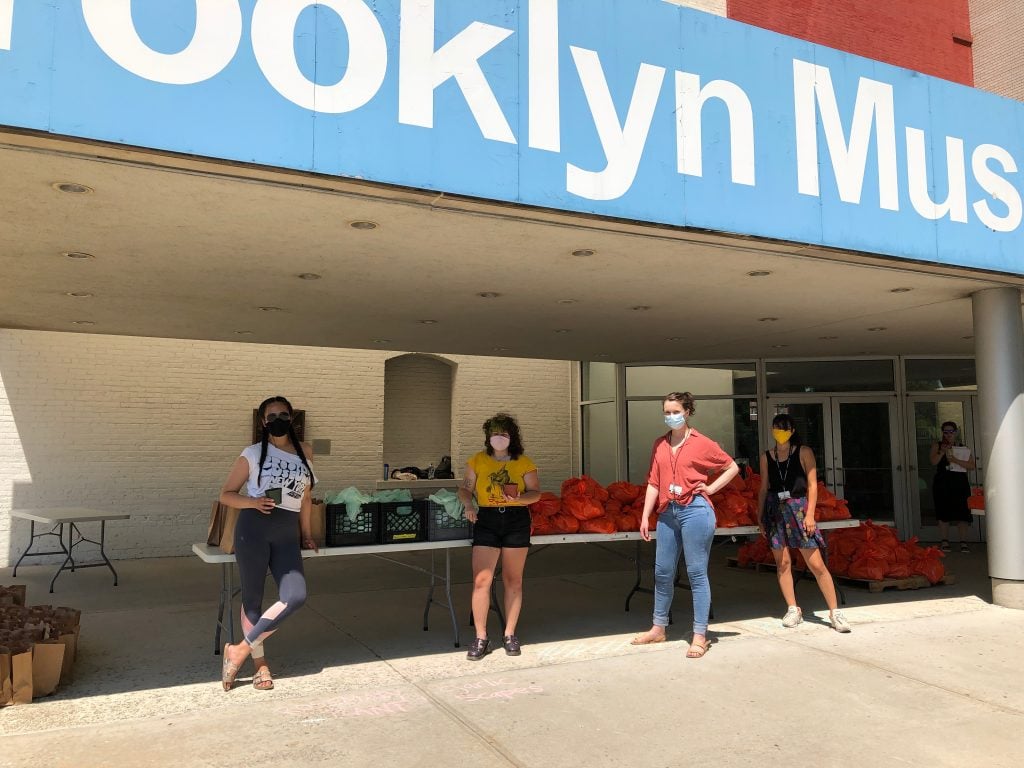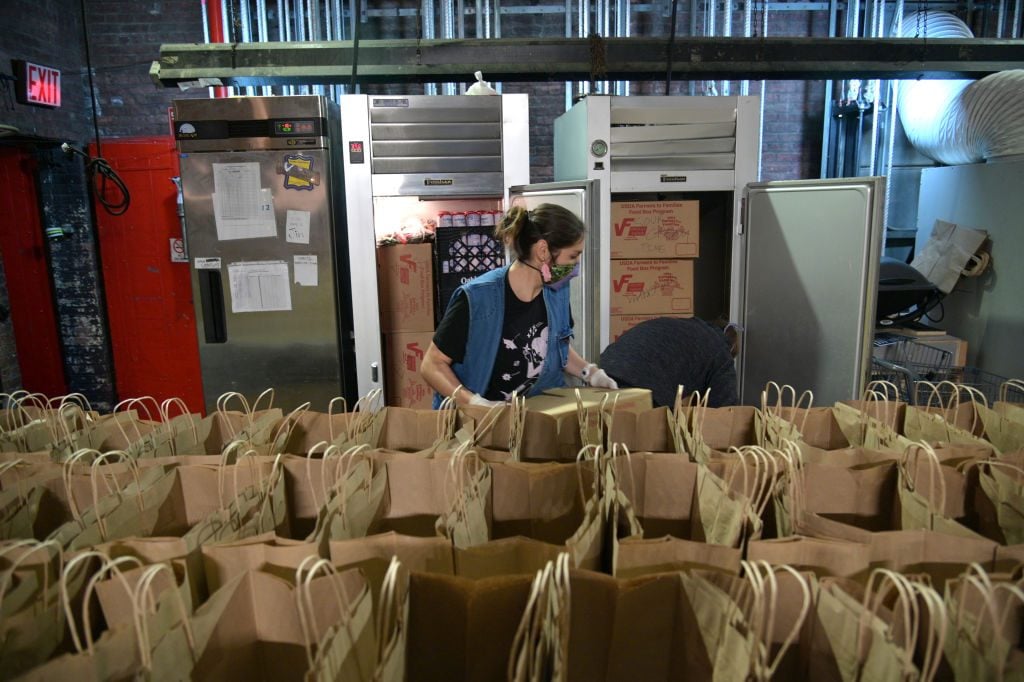Paula Santos never trained as an accountant, but for the past year, she’s been responsible for distributing more than $110,000 among arts workers who lost their jobs during the pandemic through the Museum Workers Relief Fund. It became a second job for the museum educator, who has volunteered upwards of 20 hours a week processing hundreds of applications and connecting workers with $500 grants.
Relief funds like this one, which sprung up following the first wave of sector-wide layoffs that swept American museums last March, were only supposed to last a couple of months. But some organizers are now searching for ways to permanently continue their charity drives as they receive an onslaught of requests for cash from museum workers whose furloughs turned into layoffs or who have been unable to find new jobs. The need for long-term infrastructure has only increased as other fundraisers close and the art world’s prospects for a full recovery from the pandemic stagnate.
“I had never made a mutual aid network before this,” said Santos, a manager with Intuit: the Center for Intuitive and Outsider Art in Chicago, who said she was inspired by the activism of prison abolitionist groups and the families that cared for one another in the Los Angeles immigrant neighborhood where she was raised. “I have come to believe that mutual aid is something necessary for our survival. It’s a way of showing care to those who have been furloughed or laid off in some material way.”
The dozens of mutual aid networks that have cropped up over the past year have raised millions of dollars for imperiled arts workers through a combination of individual donations, foundation grants, and matching schemes. Thousands of donors, from security guards to directors of institutions like the Brooklyn Museum, have contributed. With more than 15,000 culture workers losing their jobs last summer in New York City alone, according to a report commissioned by the city’s department of cultural affairs, relief funds became something new yet necessary for managing the pandemic’s economic impact.

Staff volunteers at Brooklyn Museum’s weekly food distribution, organized in partnership with the Campaign Against Hunger. Photo courtesy of the Brooklyn Museum.
A Broken System
As the volume of need shows no sign of contracting, some museum workers question if turning a band-aid into a lifeline will have unintended consequences in an industry that has already struggled in recent years to improve its salaries.
Akane Okoshi, an arts specialist with the Brooklyn Museum who helped raise nearly $80,000 to support more than 130 current and former employees, described the proliferation of such outlets as “a symptom of failure.” Moving forward, she said, “I would hope that institutions restructure in a way that is sustainable so that it’s budgeted for future crises.”
When Marissa del Toro lost her curatorial job at the Phoenix Museum of Art, she looked to professional groups like the American Alliance of Museums (AAM) for assistance. When none came, she turned to mutual aid groups, receiving $500 from the Arts Workers Relief Fund. That money went toward paying bills—student loans, credit cards, rent—and paying it forward. She donated remaining dollars to other mutual aid networks for racial justice and other laid-off workers.
“We should be holding those associations accountable,” she told Artnet News. “Where was their support?”
While AAM never launched its own relief fund for workers, it did advocate for federal aid on behalf of the industry and publish tips for workers looking for financial help on its website.
“After considering our expertise, capacity, and the dire situation of the field, we felt that the leadership role we could fulfill most effectively was to advocate on behalf of museums and museum professionals for economic relief on a national scale,” said an AAM spokesperson.

Kaylyn Kilkuskie, an Abrons Arts Center artist, prepares groceries for families in need throughout the Lower East Side on October 6, 2020 in New York City. (Photo by Michael Loccisano/Getty Images)
How It Works
There is no quick handbook for putting together a mutual aid network during a crisis, and many organizers told Artnet News that they had initially linked their GoFundMe pages to their personal bank accounts—something that tax experts have warned against, saying that the IRS might get curious and request additional documentation showing how the money was used.
“Throughout the entire process, we were mindful to have one bank account for all the transactions,” said Santos, who had initially opened a joint account to collect donations under her own name. Working with an accountant through tax season, she has since decided to process future donations through Open Collective, a company that helps community organizers collect and spend money.
Finding a fiscal sponsor has been an important part of navigating the logistics of fundraising, but there were many relief funds that closed last year when their contracts with those facilitators expired. That included the Metropolitan Museum of Art’s relief fund, which quietly closed its wallet after redistributing more than $110,000 to over 200 community members last year.
“Our contract with our fiscal sponsor, Artadia, expires at the end of 2020, so we must close the fund and Request for Aid form on December 31, 2020,” the group wrote on its website.
Other mutual aid networks have closed, including the Los Angeles Art Workers Relief Fund, which raised more than $85,000 last summer, distributing a total of 85 emergency grants to those in need through the organization Fulcrum Arts.
“I’m proud of the small part I played,” said Peter Mundwiler, an organizer with the fund. “I’m also proud of the LA community for pitching in at a difficult time.”
“One disappointing aspect though was the lack of engagement from journalists,” he added, blaming a lack of publicity on the difficulty of reaching more would-be donors.

The Museum of Contemporary Art Los Angeles Union. Photo courtesy of the Museum of Contemporary Art Los Angeles Union.
In It for the Long Haul
Some organizers have found donors have remained engaged. After she took a break from fundraising in December, Santos said, “we were getting emails from various people saying they really wanted to give us money.” Over the past few months, she and her colleagues have begun the process of registering Museum Workers Relief Fund as a formal nonprofit, indicating that they will be around for years to come.
Another group, Sick in Quarters, is also pursuing nonprofit status after building a mutual aid network for the disabled community that has raised nearly $5,000 during the pandemic and promoted methods of self-advocacy in the medical system. For members of the group, performing this type of care for their peers has become routine.
“We came together to help a chronically ill friend who contracted COVID-19,” said Caroline Schub, an artist and organizer with the group. “We found that when she got sick, there was no one to help fight for her except the disabled community.”
Those who have received mutual aid have a hard time imagining an art world where such a safety net no longer exists.
“I didn’t want to depend on mutual aid,” said Isaiah Newton, a former cafe server at the Toledo Museum of Art. “But I needed a boost.”
Money from the Museum Workers Relief Fund helped Newton pay his bills, putting him in a better financial position ahead of his child’s birth last month.
“I was disappointed with museums, because we acted like family. It’s hard to believe that we were cast out during the pandemic,” he said. “Receiving money was a shock; it was good to feel like I wasn’t just cast out of the industry.”










